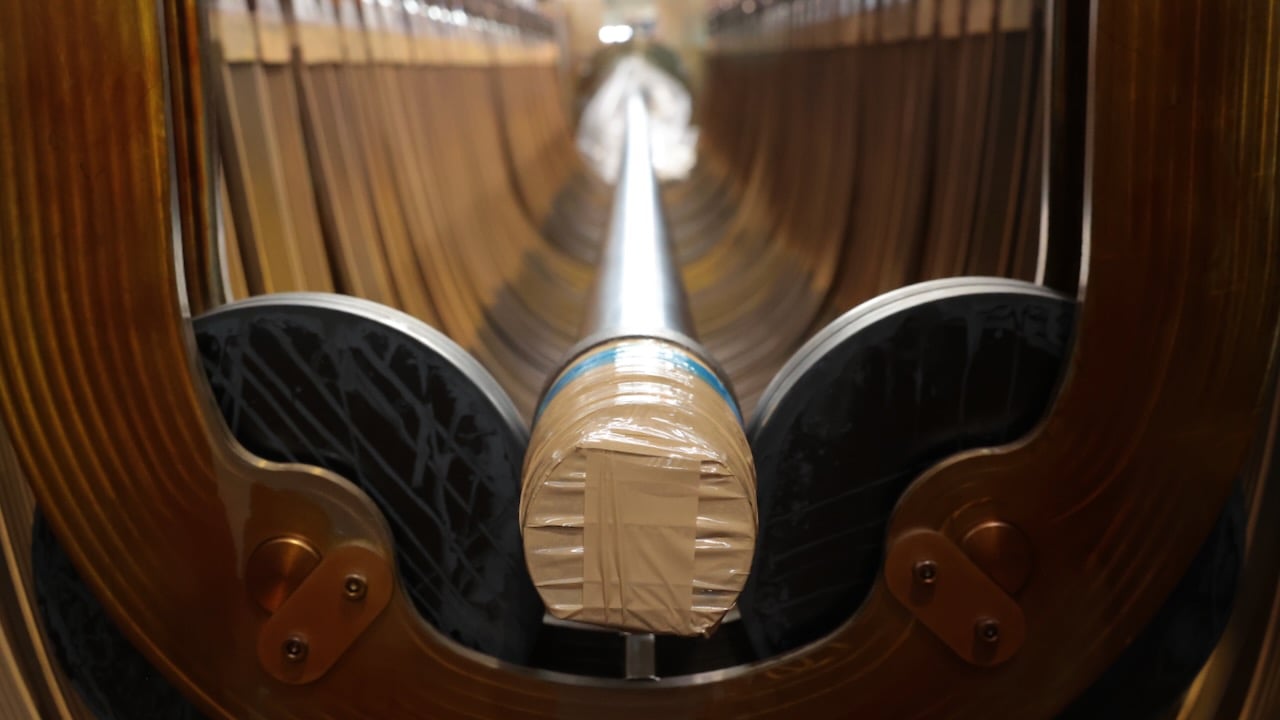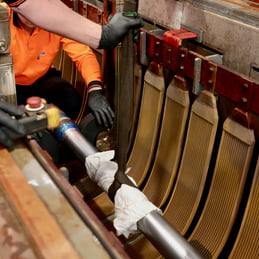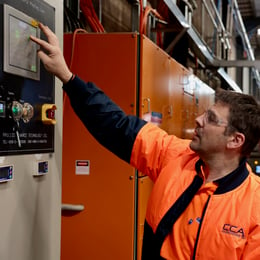Horizontal rotation hard chrome plating is a method of resurfacing extremely long hydraulic cylinder piston rods to overcome the challenges associated with these oversize components. Berendsen has pioneered this technique in Australia by investing in a purpose-built, 360-degree horizontal-rotation chrome plating tank, which is capable of handling rods up to 12 metres. In this article we explore the unique features of the system and the benefits of this process for long rods.

Background: The importance of high quality hard chrome resurfacing of hydraulic cylinder rods.
The requirements for hard chrome surfaces used in fluid power applications are demanding. These surfaces must meet precise specifications for hardness, surface thickness, and finish to maintain fine tolerances, lubrication properties, and abrasion resistance. This is particularly crucial for hydraulic cylinders with close-fitting moving parts, where the performance and longevity of the cylinder depends on high-quality hard chrome plated piston rods.
The importance of current consistency and current density in hard chrome plating:
Consistent current delivery and current density are crucial in the hard chrome plating process as they directly impact the quality and integrity of the plated layer. Current delivery refers to the consistent and stable flow of electrical current through the plating solution, while current density refers to the amount of current per unit area of the part being plated.
Maintaining consistent current delivery ensures that the desired thickness and uniformity of the chrome plating layer is achieved, avoiding issues such as uneven deposition or incomplete coverage. Deviations in current density can result in variations in plating thickness, which can lead to defects in the plated part. Therefore, precise control of current delivery and current density is vital to achieve high-quality and reliable hard chrome plated products, with consistent performance and appearance.
Challenges in rechroming extremely long piston rods:
Extra-long rods, such as those found on cranes, present unique challenges. There are few electro-plating cells that can accommodate them. As a result, ensuring even current distribution along the entire length of the rod is often impossible.
As a compromise, some may attempt to plate these rods in two stages. One end is plated first and then the rod is flipped the rod around to plate the other end. This results in overlapping chrome deposits leading to non-uniform deposition and poor adhesion. Even worse, others may opt not to rechrome the rod at all - instead using a paint-on chroming method to patch up worn areas, which is a short term repair at best.
Horizontal rotation plating system:
Horizontal rotation electroplating overcomes these challenges and achieves even, consistent chrome deposition on extra-long piston rods. In this method the rod is continually rotated during plating so that all parts of the rod surface are exposed to the current equally, resulting in uniform chrome deposit depth and concentricity.
Our facility in Kings Park NSW recently underwent extensive upgrades including the installation of a purpose-built, 360-degree horizontal-rotation chrome plating tank. This tank has been custom-engineered with a number of innovations designed to ensure high quality hard chrome plating of extra-long rods such as those found on cranes.
System Features:
12m Horizontal electroplating tank:
The system is comprised of a horizontal tank with carefully controlled bath chemistry into which rods up to 12m may be submerged. The rods are centred and fixed to a rotating hub that turns the rod at a constant rate. The even current delivery achieved through this method leads to uniform chrome deposition.
Conforming anodes:
The tank features conforming anodes to ensure even current density. As the name suggests, the anodes take the form of U-shaped belts that wrap around the rod - conforming to the cylindrical shape. In this way, we ensure that every part of the rod is an equal distance to the anode at all times.
Digital rectifier controls and tank monitoring:
Digital rectifier controls allow for precise control of electrical currents, regulating the voltage and amperage during plating, which is essential to achieve consistent plating thickness and quality. This helps in avoiding defects like burning, pitting, or uneven deposition. Additionally, tank monitoring systems provide real-time data on key parameters such as temperature, pH, and chemical concentrations, allowing operators to closely monitor and maintain optimal plating conditions. This helps in preventing over-plating or under-plating, reducing material waste and rework.
Results: 4 times thicker chrome deposits for long cylinders
The benefits of horizontal rotation hard chrome plating for restoring very long piston rods are numerous. The even and consistent chrome deposition achieved through this method leads to superior adhesion, resulting in a hard chrome finish that lasts longer and performs better in the long run. This ensures that the hydraulic cylinder rods meet the strict specifications for hardness, surface thickness, and finish, maintaining the required tolerances, lubrication properties, and abrasion resistance.
In this way, Berendsen’s technicians are achieving chrome deposit depths over 200 microns for rods of extreme length. The result is a hard chrome finish that lasts longer and performs better in the long run, providing our customers with superior quality products.
For more information about Berendsen’s hard chrome plating services or capabilities, please contact your nearest branch.









Leave A Comment